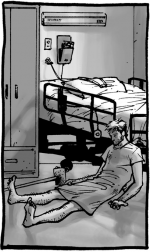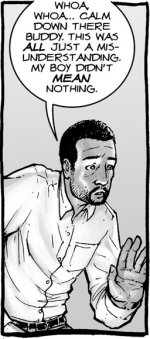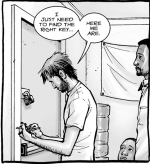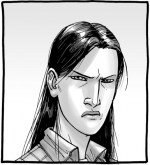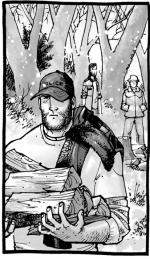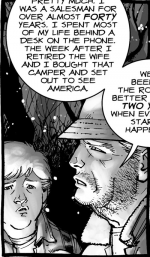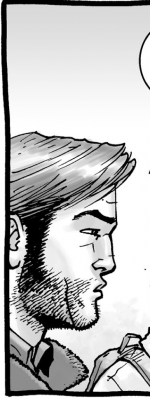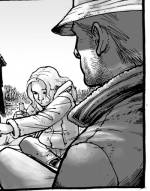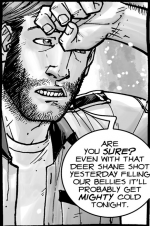Figure Description
A panel of a comic is like a small snapshot of time with a frame around a specific action, place, and character. Most often the panel is a container—and nothing more—it contains the readers view. The artist uses what is in the frame to control the emotional response of the reader. One way this can be used is how the panel frames a Character’s Figure. This section will explain the different ways you can describe a Character as they are presented within the frame of a panel.
Figure Visibility
There are many different ways to show a character’s figure within a panel. The following breaks down how to describe the more common Character figures:
- Full figure/in full: This is when a character(s) full body can be seen within the frame of the panel. You can use the terms interchangeably to match the narrative and to avoid repetitive phrasing.
In the mid-ground, Rick is visible in full figure as he sits slumped on the floor, with his back against the side of the bed
Pull in to a wide view of Rick and the horse, visible in full, as they ride from the left to the right of the panel.
- From the knees up: This is used when the frame of the panel ends at the characters knees.
Pull out to mid-view of Rick and Glenn, visible from the knees up.
Other similar examples are:
- From the hips up.
Mid view of the father from the hips up.
- From the waist up.
Mid view of Rick and Morgan from the waist up.
- From the shoulders up.
Pull into a close view of Rick, angled straight on over his shoulder, visible from the shoulder up.
- From the neck up.
Pull into a close view of Lori, visible from the neck up.
‘an extreme close up of the left side of Rick’s face.’ etc.)
- Multiple figures: Sometimes you will have a panel where there are multiple characters that are visible from different distances/perspectives, and so there will be a variety of Figure Descriptions within a single panel. In these cases you can describe these variations if it won’t detract from the narration of that panel.
Full panel description:
Wide view, angled straight on to Shane.
He is in the foreground as he walks away from the men.
He is visible from the chest up as he carries an armload of chopped wood. His lips are drawn into a small straight line.
Rick and Dale stand in the same positions behind him; they are in the midground, visible in full staring at Shane as he walks away.
Facial Visibility
A character’s face can be seen in full, in profile, in partial profile, or from behind . You should describe this as follows:
Close view of Dale from the side. He is visible in profile, with his face angled slightly upwards.
…
Donna, who sits beside Dale, stares at him with a concerned expression as he tells his story.
To the left of the panel, Rick is in profile. He looks straight forward, his thick eyebrows furrowed with intent.
Dale is in partial profile wearing his fisherman’s cap, and a jacket with the collar popped.
Beyond the Frame
There can also be instances where part of the Character’s figure is cut off by the frame of the panel. If the Character is not moving into the frame you can use the term ‘Out of Frame’. If the Character is moving into the frame you can use an active verb such as ‘leans into frame’. In other cases there can be an object that bleeds out of frame. The main rule of thumb is: if a Character or Object is out of frame we use the term ‘out of frame’.
Examples of it in use:
Rick, visible from the chest up, takes up most of the panel. One arm is out of frame.
Rick leans into the frame from the right side.
His police duffle is just visible as it bleeds off frame.
